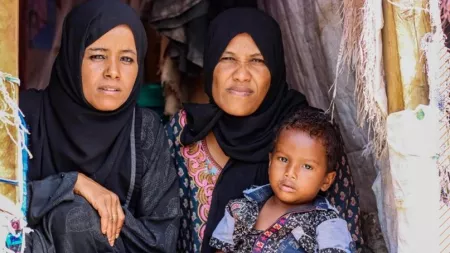“There was an accident in the community. It was very serious and the VSLAs wanted to support even though it affected people not in the VSLA group. They wanted to feel like their association could provide something for the wider community not just themselves.” – Yemen Programme Team Member
Over 300 million people around the world live in fragile contexts. And when crisis hits, their situation are typically exacerbated by lack of access to the formal financial system. We know that access to financial services can bolster economic resilience by providing people with savings to smooth over fluctuations in income, and access to credit streams can lead to investments in assets or income generating activities.
Historically, VSLAs have been considered difficult to implement within crisis setting, and there is little sectoral understanding of how to integrate VSLAs with other humanitarian modalities that target economic resilience, for example CVA. However, CARE’s new VSLA in Emergencies (VSLAiE) approach adapts the traditional VSLA methodologies to the complexities of humanitarian settings. Through this new, innovative approach, 100% of group members in the VSLAiE pilot in Yemen reported having savings with the average savings amount of $220 per member.
Funded by the Tiffany Foundation and the Sall Family Foundation, CARE’s VSLAiE pilot was implemented over 10 months in 2021 in Taiz, which has been a flashpoint of the current civil war and has experienced high levels of conflict. At first, the community was skeptical about the benefits of VSLAs and expected the groups to fail. However, through a broader sensitization and information campaign on VSLA projects, the community came to recognize how VSLAs could be beneficial.
What did we accomplish?
- Economic resilience improved for those in VSLAiE groups. In comparison to 3% at baseline, 100% of members had savings at the end of the pilot. Where previously people were borrowing from one another, they were instead drawing from their savings by the end of the project. There was also a reduction in the percentage of people relying on negative livelihood coping strategies from 39% to 28%.
- Business activities increased amongst VSLAiE members. Community members desired longer-term economic security and requested training on marketing, business skills, and vocational training. By the end of the pilot, 48% of members were engaged in business activities. Loans for business investment increased from 23% to 445 after business skills training was provided.
- VSLAiE members contributed money to others in the community who were in need. In the VSLAiE approach, the role of the VSLA Social Fund was as a mechanism for providing monetary support to struggling non-VSLA members. At the end of the project, 89% of VSLAiE members stated that they and their group had used money from the Social Fund to help households outside of the group to respond to crises.
- VSLAiE services were in high demand in the community. The pilot provided for cash transfers for 300 VSLAiE members across 16 groups. However, beyond those groups, many more people wanted to become members. Due to budget flexibility, the project offered training to an additional 609 people who then formed an additional 22 self-created groups.
How did we get there?
- Provide tools to teams to increase preparedness. CARE’s VSLAiE approach includes the provision of standard operating procedures and tools to strengthen key aspects of contextual analysis including gender analysis, and training staff on VSLAiE. Since women and girls face disproportionate burdens from crisis, including increased risk of gender-based violence and decreased access to critical health services, establishing the plans to address the specific needs and constraints of women in emergencies is a necessary first step in coordinated humanitarian response.
- Link VSLAs to CVA. The successful integration of VSLAs and CVA requires an assessment of markets, gender norms, and other needs as well as appropriate identification and targeting of households. However, it is also important that both components are kept operationally separate, that best practice is followed and particularly that access to each intervention is not made dependent upon the other.
- Ensure close accompaniment and good communication. Crisis-affected contexts are frequently quick to change and unstable. For this reason, it is important - particularly within the first cycle of a VSLA - to ensure close accompaniment and good communication channels between the team, groups, and community. Contact should be frequent, and communication should be reciprocal. The team should seek, where possible, to incorporate the views of the community back into response. This will help to build trust, ensure that opportunities can be capitalized on, and that any concerns and issues of the broader community do not escalate.
- Build a flexible cycle. The VSLAiE model allows for a cycle which can be shortened to less than the 12 months that is traditional for VSLAs to ensure that it can more appropriately deal with humanitarian programming constraints. There are trade-offs that need to be considered when deciding the length of the cycle however, including the length of time needed for full functionality to develop within the VSLA.
Where do we go next? Going forward, the Global VSLA Team will be looking to further explore how VSLAs can be used in emergency settings to achieve positive outcomes both for VSLA members and the wider community. This will include research to better understand sustainability of VSLAiE programming, the inclusion of VSLAiE in longer term humanitarian projects, programming in new contexts, and building out a toolbox for VSLAiE.
Want to learn more?
Check out the full report and the briefing
